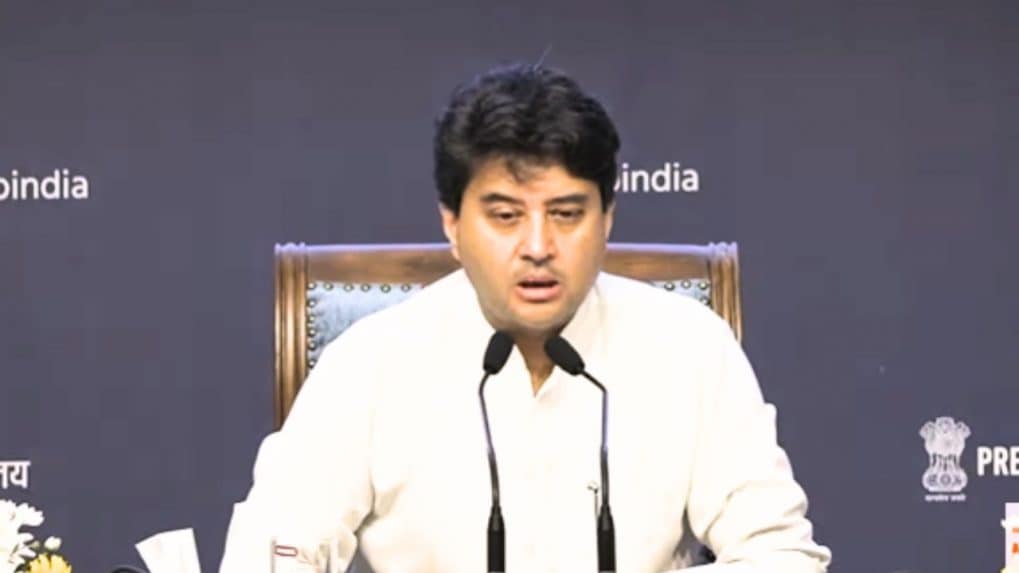India’s Telecom Revolution: Scindia says India has moved from follower to global leader in connectivity and innovation
Union Minister Jyotiraditya Scindia highlights record broadband expansion, BSNL’s turnaround, Satcom rollout, and 100% 4G saturation as India eyes leadership in 6G technology.
ADVERTISEMENT
India’s telecom sector has undergone a remarkable transformation over the last decade, evolving from a technology importer to a global leader in both services and innovation, Union Minister Jyotiraditya Scindia said while presenting the Department of Telecommunications’ (DoT) year-long performance report.
Addressing a press briefing, Scindia credited Prime Minister Narendra Modi’s 'digital highway' vision for propelling India into the world’s top three digital nations.
“The length, breadth, and depth of India’s telecom network is unprecedented. We’ve moved from being a follower to becoming a leader in telecom services and now, in products too,” he said.
The numbers, Scindia added, speak for themselves: India now has 1.2 bn telecom customers, with optical fibre coverage growing from 2 lakh to nearly 42 lakh kilometres. Internet connections have jumped from 250 million to 970 million, while broadband connections have expanded from a mere 60 million to 940 million.
“Nearly 46% of the world’s digital transactions take place in India,” the minister said, citing the Digital Public Infrastructure (DPI) ecosystem that includes UPI, which facilitates over 260 lakh crore transactions annually worth $4 trillion.
India on the Global Telecom Map
Scindia highlighted India’s rising global stature, noting that the country hosted the International Telecommunication Union’s (ITU) World Telecom Standardization Assembly (WTSA) for the first time in Asia-Pacific in October 2024.
“India has secured 11 leadership roles within the ITU, up from seven earlier,” he said, adding that the India Mobile Congress - now held in Mumbai - drew over two lakh attendees, 1,600 exhibitors, and 1,000 startups.
“We’re now planning to take it to an even higher level next year,” he said.
Policy Reforms and Spectrum Strategy
The government has undertaken key reforms to enhance digital access and network efficiency. These include relicensing the lower 6 GHz band for ultra-low-latency Wi-Fi, and spectrum refarming, where 687 MHz has been reallocated from defence and other sectors to telecom.
Read more: Satcom Summit at India Mobile Congress calls on “Space Networks for Universal Connectivity”
A second phase of refarming - Spectrum Refarming 2.0 is underway to meet the projected demand of 2,000 MHz by 2030. “We already have close to 1,587 MHz under our belt; we need another 413 MHz to meet the 2030 target,” Scindia said.
He also announced that the government had issued Satcom licenses to Jio and OneWeb, with Starlink’s approval in progress. Spectrum pricing for Satcom services will soon be finalised, he added.
India Joins Elite League in 4G–6G Manufacturing
A major highlight of Scindia’s presentation was India’s entry into the elite group of nations capable of manufacturing their own 4G, 5G, and future 6G telecom equipment. Only South Korea, China, Finland, and Sweden share this distinction, he shared.
“India is now the fifth country with its own indigenous telecom stack,” he said, noting that the core technologies developed by C-DOT and TCS have already been rolled out across one lakh towers.
Read more: We missed the 4G and 5G bus, not 6G: Telecom Minister Jyotiraditya Scindia
The Bharat 6G Alliance, Scindia added, is actively preparing India to contribute at least 10% of global 6G patents, the Minister highlighted.
BSNL’s Turnaround After 17 Years
Scindia termed BSNL’s financial revival as one of the “most remarkable achievements” of the telecom ministry. After 17 years, BSNL turned profitable at the operational level, recording ₹262 crore in Q3 FY25 and ₹280 crore in Q4 FY25.
Read more: BSNL gets Rs 3.28 lakh cr in revival aid since 2019; over 90,000 4G sites now live
“BSNL’s EBITDA has jumped threefold to ₹5,395 crore, and its losses have been reduced from ₹5,500 crore to ₹1,400 crore,” he said.
The state owned telco has added over 80,000 new towers, taking its total to 97,000.
Driving 100% Network Saturation
Under the government’s “100% telecom saturation” mission, India has achieved 75% of its target within a year. Out of 17,000 towers planned under the 4G Saturation Project, 13,000 have already been installed.
The aspirational district scheme has reached 81% saturation, while Left-Wing Extremism (LWE) affected regions have achieved up to 96%. For island territories, execution has improved from 38% to 84%.
Read more: Sanchar Saathi resolved 2 cr requests as of Sept ; 31 resolutions every minute: Jyotiraditya Scindia
To accelerate pending projects, the ministry created a real-time dashboard to monitor and resolve land, forest, and security-related issues.
Digital Security and Citizen Protection
Scindia also underscored DoT’s advances in telecom security. AI-based tools like ASTR have disconnected 82 lakh fraudulent mobile connections, while the Financial Fraud Risk Indicator system has prevented scams worth nearly ₹200 crore.
“Google has now joined this effort, which is a huge fillip,” he noted. A unified digital intelligence platform (DIP) now enables data sharing among 750 government and private entities, including all state governments, banks, and law enforcement agencies.
TRAI has introduced monthly reporting for service quality, replacing the earlier quarterly cycle. Telecom operators are now required to map towers publicly and ensure benchmarks such as less than 2% drop call rates and latency below 50 milliseconds by April 2026.
The ministry has also established a single-window clearance portal to reduce right-of-way approval timelines from four months to just 15 days.
Read more: Union Minister Jyotiraditya Scindia launches AI-powered IMC 2025 app
Scindia concluded by emphasizing the ministry’s shift towards accountability and collaboration. “Every chief general manager at BSNL is now a CEO of their circle, setting quarterly targets and reviewing them regularly,” he said.
In a first-of-its-kind exercise, the DoT recently held a “9-to-9” marathon review meeting - from 9 a.m. to 9 p.m. - to assess performance and share best practices.
“India’s telecom story is one of transformation, resilience, and leadership,” Scindia said.

